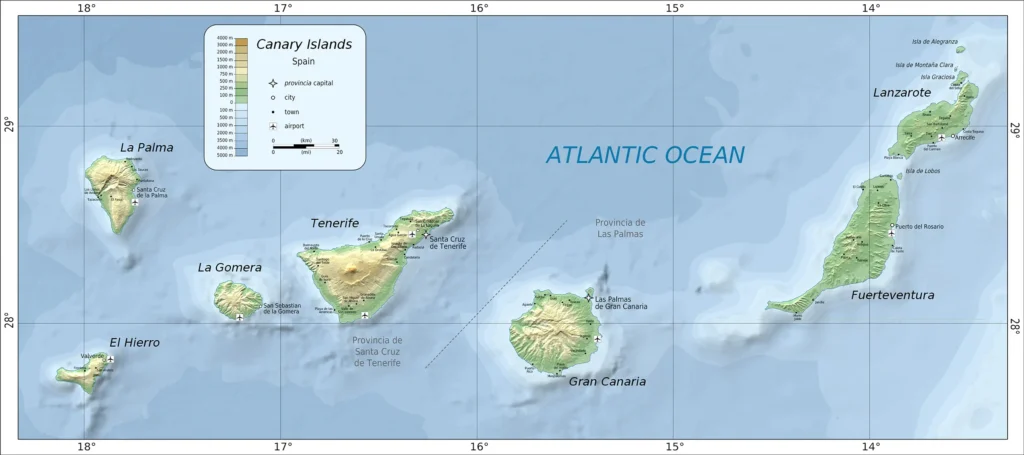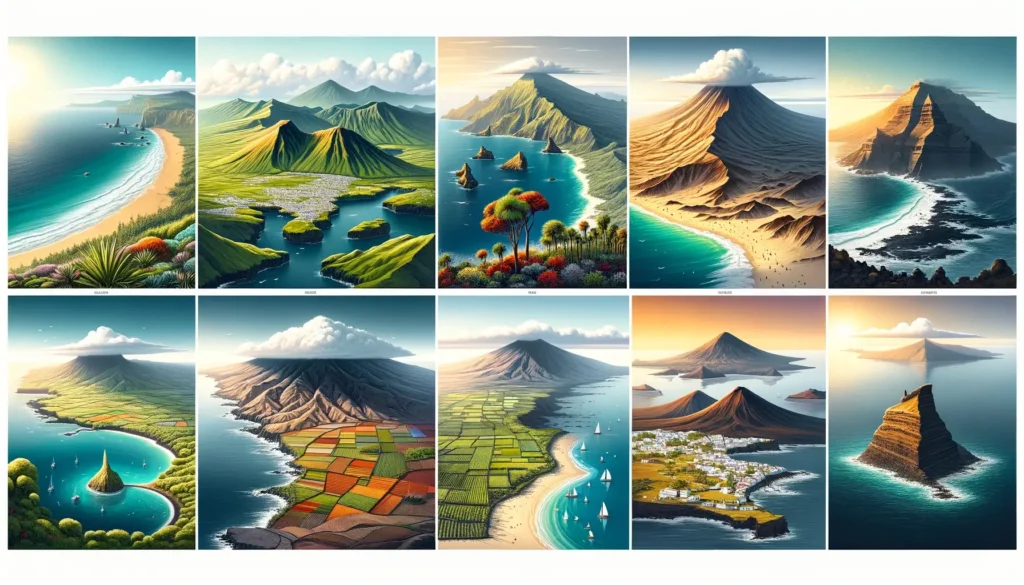
Webpage content
The Canary Islands (Las Islas Canarias) are an archipelago in the Atlantic Ocean, comprising 8 large and 5 small islands. All of them are of volcanic origin. The Canary Islands belong to Spain, but they are geographically closer to Morocco.
- Tenerife
- Gran Canaria
- La Gomera
- La Palma
- Lanzarote
- Fuerteventura
- El Hierro
- La Graciosa
The archipelago’s name comes from the Latin Canariae Insulae, which translates to “Islands of the Dogs”. In the past, large dogs inhabited the Canaries, discovered by the first expedition of the King of Mauretania, Juba II. Two specimens were captured and taken back to Mauretania. This eventually gave the archipelago its name in general. This theory is supported by the works of the ancient Roman scholar Pliny.
The Canaries are a popular vacation spot for European tourists. Thanks to the unique climate, the resort season on the archipelago lasts all year round. Besides beach vacations, the Canaries attract visitors with unique nature, delicious cuisine, a wealth of attractions, and excellent infrastructure.
History of the Canary Islands

The Canary Islands have been populated since ancient times. The indigenous people include the Guanches, Bimbaches (El Hierro), Auritas, and Mahoreros. They were related peoples but had significant cultural differences. Before the arrival of Europeans, the inhabitants of the Canaries had little interaction with each other.
According to descriptions by Spanish and other conquerors, the Guanches were of the Caucasian type, with fair skin, blonde or dark hair, and grey or blue eyes.
Descriptions of the Guanches’ unique language have survived to the present day—they could communicate merely by moving their lips. Equally interesting is the whistling language used to send messages over long distances. The whistling language, Silbo Gomero, is still preserved on the island of La Gomera.
Various theories have been proposed about the origin of the Guanches and other indigenous peoples, including their connection to the inhabitants of ancient Atlantis.
Modern scientific theories link the Guanches with the Berbers since their languages are similar.
However, there is no definitive answer to this question, as the anthropological type of the Canary Islands’ indigenous population does not correspond to the geographic latitude.
The aborigines (Guanches) practiced agriculture and livestock breeding, raising pigs, goats, and sheep. They made their tools from stone and obsidian. They lived in natural and man-made caves. Tribes were governed by chiefs.
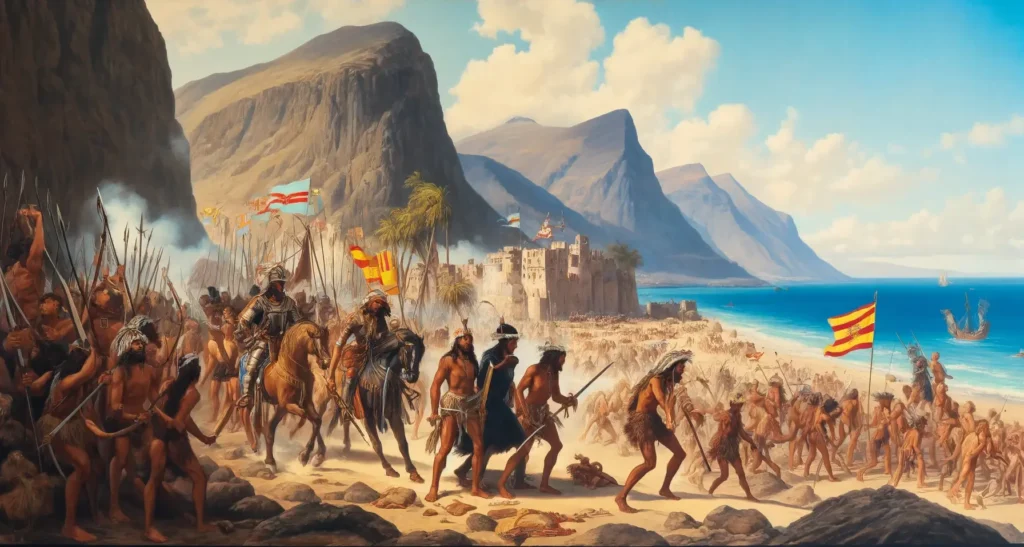
The conquest of the archipelago by Europeans began in 1402. Gran Canaria and La Gomera were captured by the French and declared lands of Castile and León. In 1404, Jean de Bethencourt was proclaimed King of the Canaries.
The inhabitants of Tenerife resisted and tried to fight the invaders, leading to significant losses among the Guanches. Tenerife began to be conquered by the Spanish in 1494, and on September 29, 1496, the complete subjugation of the Canaries was declared.
Most of the aborigines later died from various strains of influenza, typhus, tuberculosis, and other diseases brought by Europeans.
The Canaries acquired special significance after Columbus discovered America. They became an important stopover on the route from Europe to America. For this reason, the archipelago was a desirable prize for conquerors and often suffered pirate attacks. The Canary archipelago was repeatedly captured by Moroccans, Dutch, and British.
In 1586 and 1596, the Moroccans captured Lanzarote.
In 1959, Las Palmas was attacked by ships under Francis Drake.
In 1599, the Dutch destroyed Las Palmas.
In 1657, the British under the command of Robert Blake demolished Spanish ships, fighting for Tenerife.
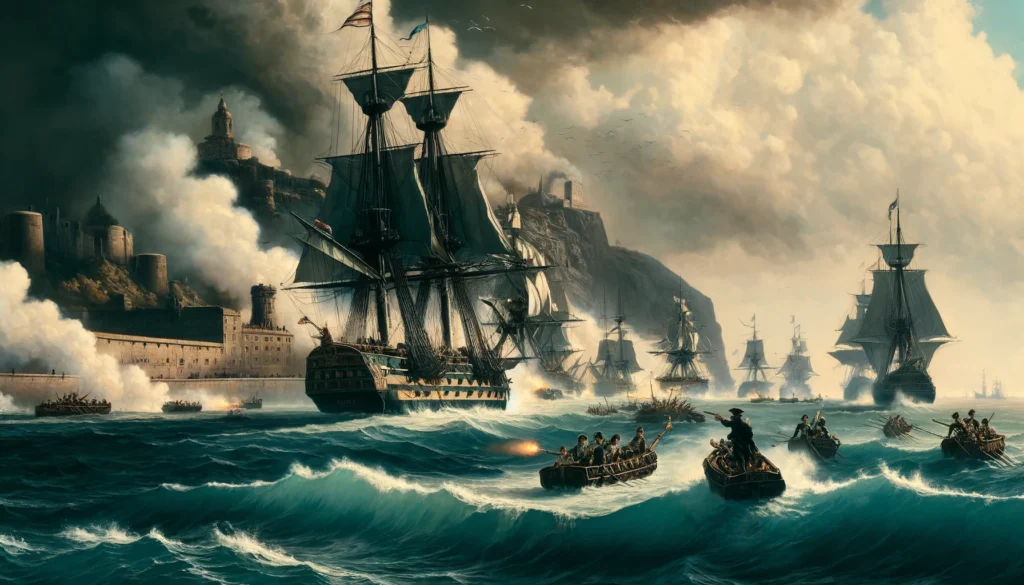
In 1797, ships commanded by Admiral Nelson attempted to capture Santa Cruz de Tenerife. It is believed that it was in this battle that he lost his arm.
From 1821, Las Islas Canarias became part of Spain with the capital in Santa Cruz de Tenerife.
Climate of the Canary Islands

Despite their proximity to the African coast, the climate of the Canaries has very little in common with Africa. The entire archipelago enjoys a tropical trade wind climate, characterized by minimal temperature fluctuations, warm and dry weather. The local climate zone is significantly influenced by the interaction of moist trade winds from the Atlantic Ocean and dry harmattan winds from Africa.
No island in the Canary archipelago ever gets cold, even in the midst of winter, and there is no rainy season.
The temperature on the Canary Islands is quite comfortable at any time of the year. However, due to the terrain, individual islands have their own climatic features. Tenerife, La Palma, and Gran Canaria have volcanoes and mountains affecting the weather in different parts of them. It is usually dry and warm at the foot of the mountains, but the higher up, the lower the air temperature. Mountain peaks are adorned with a snow cap in winter. This creates a great climatic diversity, for example, Tenerife has 28 microclimatic zones, and the weather in the north and south significantly differs despite the relatively small size of its area.
Tenerife is known as the “island of eternal spring,” with an average annual temperature changing insignificantly, with fluctuations of no more than 7 degrees. On Gran Canaria, the minimum daytime temperature in winter is +20°C, in summer +30°C. Lanzarote is known for almost complete absence of rain, while Fuerteventura is known for stable temperatures throughout the year and strong winds.
Weather on the Canary Islands by Months

Weather in January
The Canary Islands delight with warm comfortable weather in winter. On the largest island of the archipelago, Tenerife, daytime temperatures in January do not drop below +20°C, at night +14°C, but sometimes it rains during this period. The ocean water temperature is +19°C. On Fuerteventura, the air warms up to +25°C during the day, at night +14°C. Gran Canaria also pleases with warmth, the air temperature on it is a couple of degrees higher than on Tenerife, with fewer rainy days. Lanzarote is cooler in winter: the air warms up to +19°C during the day, at night – to +13°C. Similar temperature indicators are on La Palma.
Weather in February
The weather on the Canary Islands in February is quite conducive to relaxed vacations. On Tenerife, Fuerteventura, the air temperature does not change much and stays at +14 – +20°C. A bit warmer on Gran Canaria — +15-+21°C, with daylight lasting about 11 hours. On Lanzarote and La Palma, the air warms up to +13-+19°C.
Weather in March
March on the Canaries is quite warm, the weather is excellent for excursions and travels. The ocean water temperature is +18-19°C, which does not favor swimming, but you can sunbathe on the beaches. This period is also loved by fans of water sports. On Tenerife, the air temperature in March is +15°C at night and +21°C during the day, daylight lasts 12 hours Similar weather at this time on Fuerteventura and Lanzarote, 1-2 degrees warmer on Gran Canaria. On La Palma, the air warms up to +20°C during the day, at night to +14°C.
Weather in April
In April, it gets even warmer on the Canary Islands, the ocean water warms up to +20-21°C, daylight increases to 13 hours. During this time, everything turns green, the weather is warm but not hot. An ideal time for active vacations and trips to this paradise corner. On Tenerife and Fuerteventura, daytime air temperature reaches +22°C, at night +15°C. On Gran Canaria, it’s one degree warmer. On Lanzarote during the day +20°C, at night +13°C, La Palma — +14-+21°C.
Weather in May
In May, the active tourist season begins, facilitated by an increase in the average daily air temperature. On Tenerife during the day +24°C, at night +16°C, daylight lasts 14 hours. There is almost no rain. Similar temperature indicators in May are also on Gran Canaria. In May, Fuerteventura attracts lovers of surfing and windsurfing. During the day it’s warm +23°C, at night +16°C. On Lanzarote, the air temperature is the same as on Fuerteventura, but there are no strong winds. This is an excellent time to see the local national park. On La Palma, the temperature indicators are at +22°C during the day and +15°C at night.
Weather in June
June on the Canaries is already quite comfortable for a full-fledged beach vacation. The ocean is not yet hot milk but warms up to acceptable +21°C. The air temperature on Tenerife and Gran Canaria during the day reaches +26°C, at night +18°C, daylight lasts 14 hours. On Fuerteventura and Lanzarote — comfortable +18-+25°C open new opportunities for active recreation and walks. On La Palma, it’s a bit cooler — +17-24°C, but also quite warm.
Weather in July
In July, the Canary Islands are visited by the maximum number of tourists, the resort season is in full swing. The weather in July is perfectly suitable for beach vacations, the ocean warms up to +22-23°C, daylight lasts 14 hours. The air temperature on Tenerife, Gran Canaria, Fuerteventura rises to +27-28°C during the day and to +19-20°C at night. On Lanzarote and La Palma, it’s a couple of degrees cooler.
Weather in August
In August, the temperature indicators reach their annual maximums, the air warms up to +29°C and above during the day, at night — to +21°C, the ocean water temperature — +23-24°C. It’s equally warm throughout the Canary archipelago.
Weather in September
In September comes the golden age, there are fewer tourists, but the weather pleases with warmth, sun, and gentle sea. On Tenerife and Gran Canaria, the air warms up to +28°C during the day and to +20°C at night, the ocean warms up to +23°C. Daylight in September lasts 12 hours. On Fuerteventura, Lanzarote, and La Palma, the air warms up to +26-27°C during the day and to +20°C.
Weather in October
October is a great time to spend time on the Canary Islands. At this time, the ocean is still quite warm, the air temperature during the day is +25-27°C, at night +22-23°C. Daylight slightly decreases, in October it is equal to 11 hours. The first rains already occur in October.
Weather in November
November is still quite comfortable for beach vacations, the water temperature remains at +22-24°C, the air warms up to +23°C during the day and +17-18°C. In November, Tenerife and La Palma count up to 8 rainy days, On Gran Canaria and Fuerteventura – 3-4 days with rain, daylight lasts 11 hours. Rains, as a rule, are short-term and do not interfere with rest. This is an excellent time for excursions.
Weather in December
In December, the ocean water cools down to +20°C, but warm weather remains. During the day on the Canary archipelago, the air warms up to a comfortable +20-22°C, in the evening and at night, warm clothes may be needed, as the air temperature does not exceed +14-16°C. Daylight in December lasts 10 hours.
Geography of the Canary Islands
How many Canary Islands are there? 7 large and 6 small ones. The largest in the Canary archipelago is Tenerife, its area is 2057 sq. km. The second-largest is Fuerteventura (1659 sq. km). The third is Gran Canaria (1532 sq. km). Followed by: Lanzarote (795 sq. km), La Palma (708 sq. km), La Gomera (378 sq. km), and El Hierro (277 sq. km). Of the small ones, only La Graciosa is inhabited. The Canary archipelago, along with the Azores, Cape Verde Islands, and Madeira, form Macaronesia. Where are the Canary Islands? If you find the Canary Islands on a world map, it becomes clear that they are geographically much closer to Africa than to Europe. The distance to the coast of Spain is 1300 km, and to Africa – 96 km. Map of the Canary Islands
On the map, the Canary Islands are located in a semicircle from southwest to northeast, stretching for 500 km. Las Islas Canarias are located in the Atlantic Ocean. They are situated between 27°38′ and 29°35′ north latitude and 13°20′ and 18°14′ west longitude.
Transportation in the Canary Islands
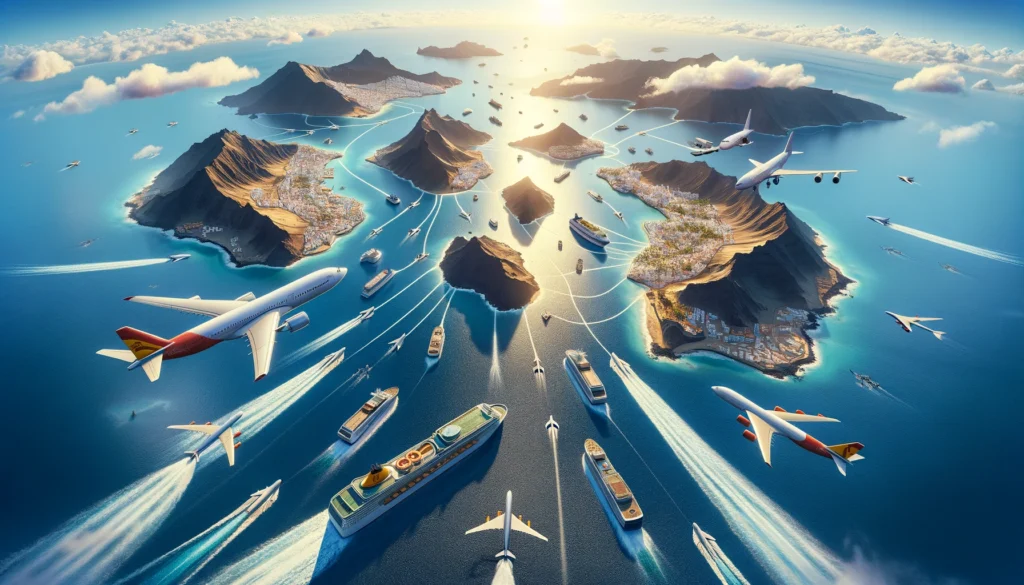
The transport system of the Canary Islands can be divided into two types: connecting them with each other and serving a specific island. There is a transport connection between mainland Spain and the major islands by air and sea.
Ferries
Ferries operate between the mainland and the Canary Islands and among some of them. A ferry trip from Spain to the Canaries will be quite long. Sea ferry transportation is provided by the company Trasmediterranea. Its ferries depart from the city of Cadiz to Gran Canaria and Tenerife. The journey to Tenerife takes 60 hours, to Gran Canaria — 40 hours. A ticket for a seat will cost about 150 euros, a separate cabin is significantly more expensive – about 600 euros. Ferries run between Spain and the Canaries 4 times a month. Tickets can be purchased online on the company’s website. The exact schedule is also available there. Ferry communication between the islands is carried out by three companies:
- Fred Olsen
- Naviera Armas
- Acciona Trasmediterranea
Ferries of these companies differ in price, speed of movement, and schedule. The fastest ferries are operated by Fred Olsen, for example, the journey from Gran Canaria to Fuerteventura by Fred Olsen ferry takes about two hours, while the journey on Armas and Acciona ferries takes six hours. From Tenerife to Gran Canaria, the Fred Olsen ferry takes an hour, while Armas and Acciona take 3-4 hours. However, the cost of the trip also differs, a trip by Fred Olsen ferry will cost 45-84 euros, Armas and Acciona – 23-36 euros.
Air Communication
Flights to the Canary Islands are possible from Spain and other European cities. All islands of the archipelago have international airports, and Tenerife even has two, located in different parts of it, – in the north and in the south. Airports accept international and domestic flights. The best chances of buying inexpensive tickets are for flights from Barcelona and Madrid, where airlines Iberia, Air Europe, Spanair, Jet Airways, Smart Wings, Vueling, Edelweiss fly. It is also possible to look for flights with a stopover in Berlin, Prague, Brussels.
Airplanes can also be used for trips to a neighboring island of the archipelago. Planes of the airlines Canaryfly and Binter Canarias fly between them all. Such flights are very short, the longest flight Tenerife – Lanzarote lasts an hour, flights to other islands of the archipelago take no more than half an hour.
If there are plans for such a trip, it is better to buy tickets in advance, internal flights are quite popular.
Airports of the Canary Islands
- Tenerife
- 1. Tenerife South Airport
- 2. Tenerife North Airport
- Gran Canaria: Gran Canaria Airport (Las Palmas)
- La Palma: La Palma Airport, Santa Cruz De La Palma
- Fuerteventura: Fuerteventura Airport
- Lanzarote: Lanzarote Airport
- La Gomera: La Gomera Airport
- El Hierro: El Hierro Airport
- La Graciosa: only by ferry
Air tickets to the Canary Islands
Language in the Canary Islands
Heading on a trip, many are concerned about the question — what language is spoken in the Canary Islands? The Canaries belong to Spain, accordingly, the only official language is Spanish (Castilian). However, the remoteness from the mainland, the influence of the language of the indigenous population, has led to the formation of the Canarian dialect of the Spanish language. It is similar to Andalusian but has its characteristic features.
In large cities and resorts, standard Spanish is usually used, but in small villages and where the local population prevails, the Canarian dialect is used, characterized by shortening words, differences in the pronunciation of some sounds. The speech of the Canarians can be difficult to understand also because of some words that have survived only in the Canaries and have long been forgotten on the mainland. The Canarian dialect also includes a number of borrowings from the Guanche language.
On La Gomera, the unique whistling language Silbo is still preserved to this day. It was used by the indigenous people to transmit messages over long distances.
Attractions of the Canary Islands
What to see in the Canary Islands? This question is asked by every tourist planning a vacation. The Canaries are so rich in natural and historical attractions that the only difficulty that may arise is how to fit all excursions into the limited vacation time.
Tourists have at their disposal unique natural parks and reserves, architectural monuments, entertainment infrastructure.
Teide Volcano
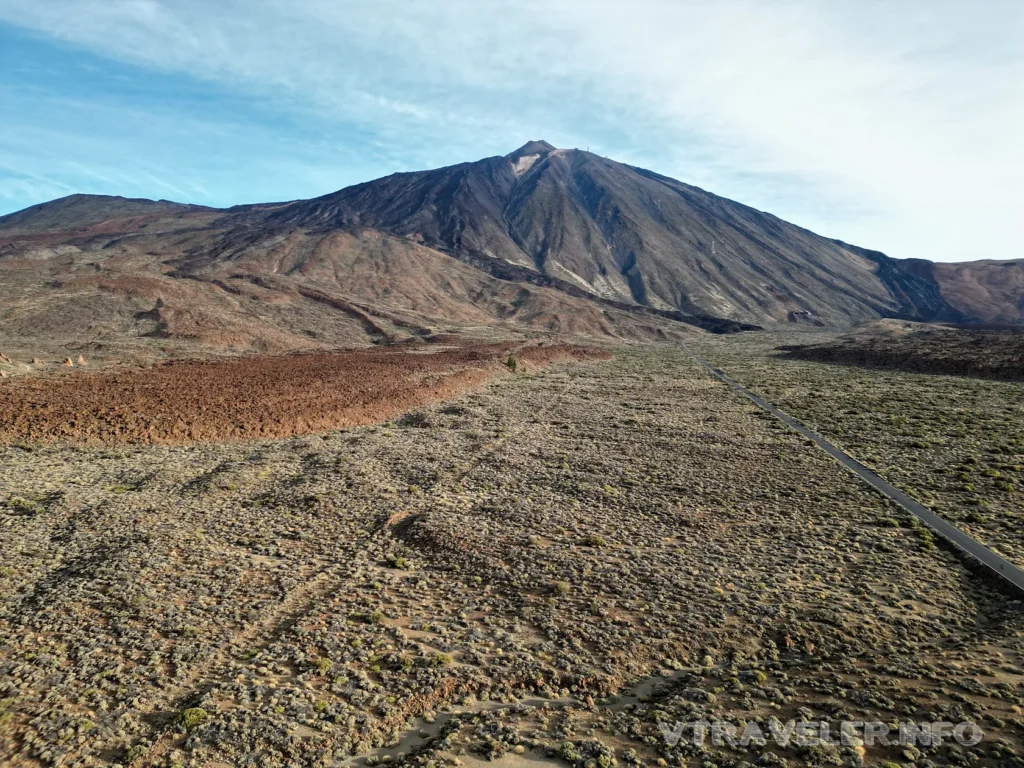
Teide. The most famous natural attraction of the Canaries is located on Tenerife. Teide Volcano is the highest point in Spain, its height is 3718 m. It is surrounded by Teide National Park, where you can see unique endemic plants, fantastically shaped rocks, and alien landscapes.
Corralejo Natural Par

Corralejo Natural Park (Parque natural de Corralejo) is located in the northeast of Fuerteventura. Its territory includes the famous El Jable dunes, Montaña Roja volcano, and magnificent beaches. The vegetation in the park is sparse, desert-like, but the park is home to exotic birds, rare insects, and reptiles.
Timanfaya National Park
Timanfaya National Park (Parque Nacional de Timanfaya) is located on Lanzarote. This park has fantastic landscapes of volcanic origin, reminiscent of Martian. Its territory is home to about 220 dormant small and medium-sized volcanoes. The park covers an area of 51 sq. km.
Anaga Ancient Forest

Anaga Ancient Forest on Tenerife will appeal to nature lovers and hikers. It is located on the northeastern slope of Teide volcano. Most of the trees in the forest look the same as they did 20 million years ago. Anaga Forest has preserved unique species of endemic plants.
Maspalomas Dunes
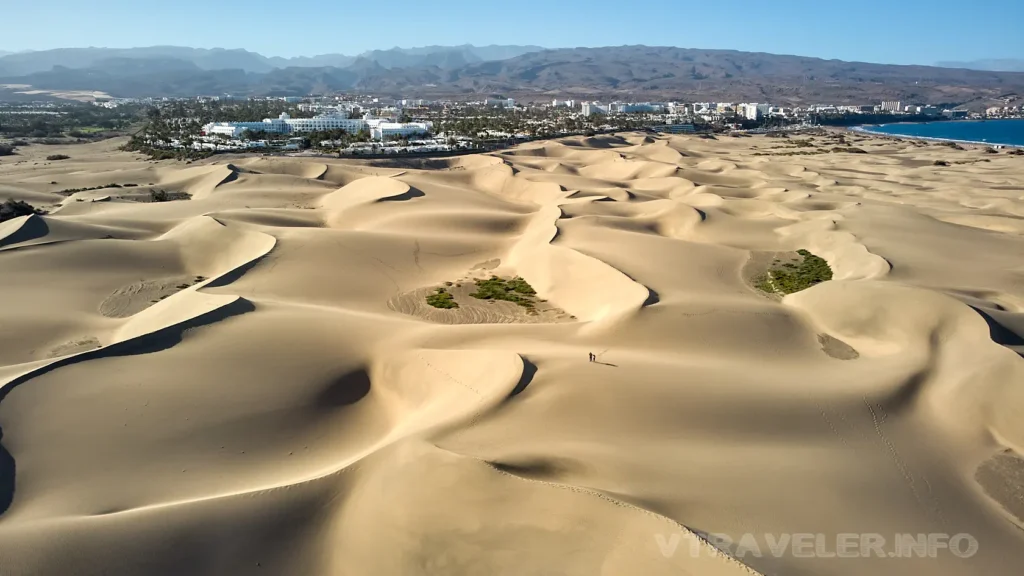
Maspalomas Dunes (Dunas de Maspalomas) — a place of fantastic beauty located in the southern part of Gran Canaria. They cover an area of 403 hectares and are a miniature desert. Among the dunes, you can meet rare animals and unique plants.
Masca Gorge
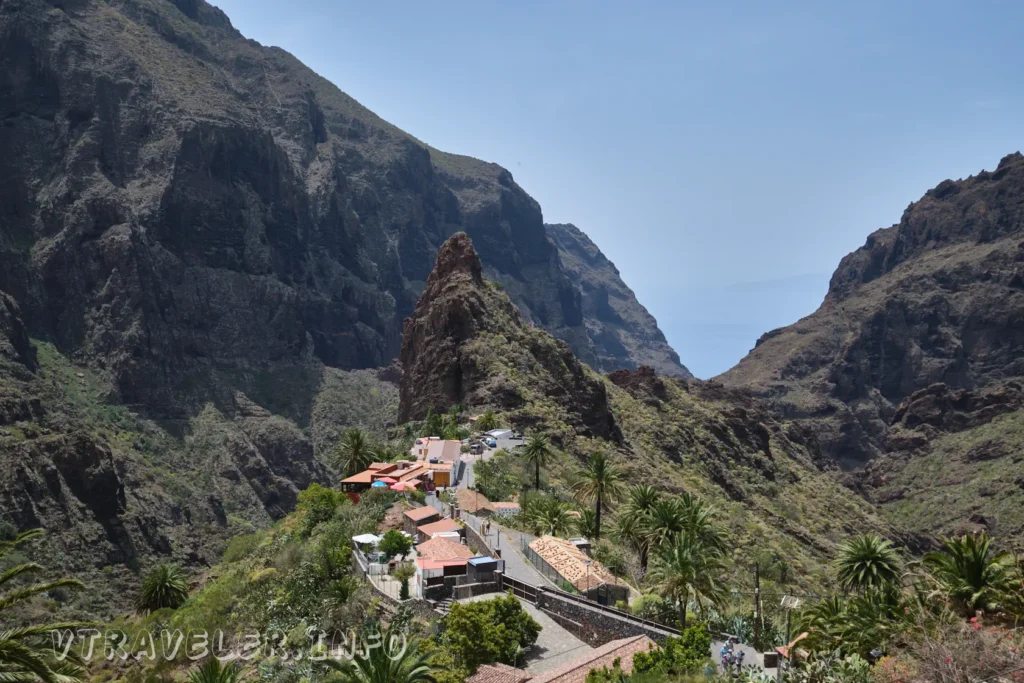
Masca Gorge (Barranco de Masca) — a natural attraction on Tenerife, a place that will appeal to lovers of beautiful landscapes. The gorge is of volcanic nature. It is located in the northwest, near the cliffs of Los Gigantes. There is a hiking trail through Masca Gorge stretching for 9 km.
Tamadaba National Park
Tamadaba National Park (Parque natural de Tamadaba) — the largest attraction of Gran Canaria. The park is located on 7.5 thousand hectares at an altitude of 1000 meters above sea level. Several dozen species of plants grow in the park, found only here.
Green Lagoon (Charco Verde)
Green Lagoon (Charco Verde) — one of the main attractions of Lanzarote. The lagoon was formed in 1730 as a result of a volcanic eruption. Green Lagoon is a small lake with bright green water surrounded by volcanic rocks.
Jameos del Agua Caves
Jameos del Agua (Jameos del Agua) caves on Lanzarote are part of a cave complex. Unlike other caves, Jameos del Agua was altered by man. Under the guidance of Cesar Manrique, a unique complex was created. The cave consists of a couple of grottos, an open gallery, and an artificial lagoon with turquoise water. A concert hall is organized in the large grotto. There is also an underground restaurant in the complex.
Wolf Island
Wolf Island (Isla de Lobos) is located near Fuerteventura, attracting untouched wild nature and the opportunity to see endemic plants.
Guimar Pyramids

Guimar Pyramids (Pirámides de Güímar) — an interesting architectural monument located on Tenerife. The pyramids have a correct geometric shape and are built from volcanic stones. Who exactly built them is unknown.
Columbus House-Museum
Columbus House-Museum (Casa Museo de Colón) — the main attraction of Gran Canaria. It is the former residence of the governor, built in the distant 15th century. The museum’s exhibition is located in 12 halls, in the courtyard, and even in the basement.
Archaeological Museum and Painted Cave
Cueva Pintada Museum-Park (Museo y Parque Arqueológico Cueva Pintada) — a large museum complex built on the site of a former Guanche settlement on Gran Canaria. Excavations are being carried out on the museum’s territory.
Salt Museum
The Salt Museum (Museo de la Sal) is located on Fuerteventura, its exposition introduces the process of sea salt extraction.
Viera y Clavijo Botanical Garden
Viera y Clavijo Botanical Garden on Gran Canaria (Jardín Botánico Canario Viera y Clavijo) is located on mountain slopes, its territory contains a huge collection of rare plants from all over the world. The botanical garden covers an area of 27 hectares.
Palmitos Park
Palmitos Park (Palmitos Park) is located in the south of Gran Canaria, combining the functions of a nature reserve, zoo, and entertainment area. The park has a large collection of plants, insects, and animals, including 1000 species of palms, 150 species of birds.
Loro Park
Loro Park (Loro Parque) — one of the most wonderful places on Tenerife. The park is home to about 300 species of parrots, as well as penguins, dolphins, and orcas, and other animals.
Oasis Park
Oasis Park (Oasis park) — a nature area in the southeast of Fuerteventura, covering an area of 80 sq. km. The park successfully combines a botanical garden, zoo, and contact zoos.
The Best Island in the Canary Islands
There is no definitive answer to the question of which Canary Island is the best. It is best to start getting acquainted with the Canaries from Tenerife. It is the largest island by area, with a well-developed tourist infrastructure, beautiful beaches, and numerous attractions.
For a measured calm vacation, Fuerteventura is suitable, it attracts with its many kilometers of beaches, a small number of people. It is also very popular among surfers.
Each island of the Canaries is unique and has its unique features. The second most popular among tourists is Gran Canaria. In the center of it is the long-extinct volcano Pico de las Nieves. Gran Canaria is a continent in miniature, where the desert is replaced by jungles and the sea coast with three hundred beaches.
Which island to choose when going to the Canaries? It all depends on what kind of rest you prefer. The first thing to consider is transportation, Tenerife and Gran Canaria are much more developed as resorts. The airports of these islands accept a huge number of flights from all over the world. This allows you to choose a convenient connection and buy inexpensive plane tickets.
Tenerife is famous for its natural and climatic diversity. Here you can always find a resort to your liking: the lively Las Americas, respectable Costa Adeje, surfers’ dream El Medano, calm Puerto de la Cruz.
Gran Canaria attracts with its chic sandy beaches and dunes, there are many resorts where surfers and windsurfers come.
On Fuerteventura, La Palma there are beautiful beaches and hotels, but they have their specificity. Fuerteventura is constantly windy, so it is more suitable for water sports. La Palma attracts with a sea of greenery, unique relief, and camphor beaches. It is also interesting for divers, for those who love active recreation, hiking.
Lanzarote and La Gomera are more interesting as a place to go on a one- or two-day excursion while resting on Tenerife or Gran Canaria.
Communication, Internet on the Canary Islands

Modern Communication in the Canary Islands: Everything You Need to Know
Mobile Communication for Everyone: The Canary Islands are serviced by leading operators: Movistar, Orange, Vodafone, and MásMóvil, providing quality 4G/LTE coverage. For citizens of the European Union, roaming in the Canaries, as in all of Spain, does not entail additional expenses thanks to the “Roam Like at Home” policy. Tourists from other countries are recommended to buy a local SIM card to save money.
High-Speed Internet: The islands are well-equipped with broadband internet access via ADSL and fiber optics in cities and resorts, and in more remote places – through mobile networks and satellite. Free Wi-Fi is widely available in cafes, restaurants, and public spaces.
Innovation and Development: It was recently announced that the introduction of 5G networks on the most popular islands has begun, promising to revolutionize mobile internet access, providing even higher speed and reliability of communication.
Tips for Travelers: EU citizens do not have a problem with roaming, but it’s worth checking the conditions of your tariff before the trip. Non-EU citizens, we advise renting a portable Wi-Fi router or buying a local SIM card with sufficient data volume.
Choosing an Operator: Determine your needs and route in advance to choose the operator with the best coverage in the areas of interest to you. Check current offers and tariffs directly with operators or at their sales points on the islands.
Conclusion: Thanks to modern communication technologies, the Canary Islands provide their guests and residents with reliable access to mobile communication and the internet. Use our tips to stay connected while exploring the beauties and uniqueness of this amazing archipelago.
Hotels of the Canary Islands
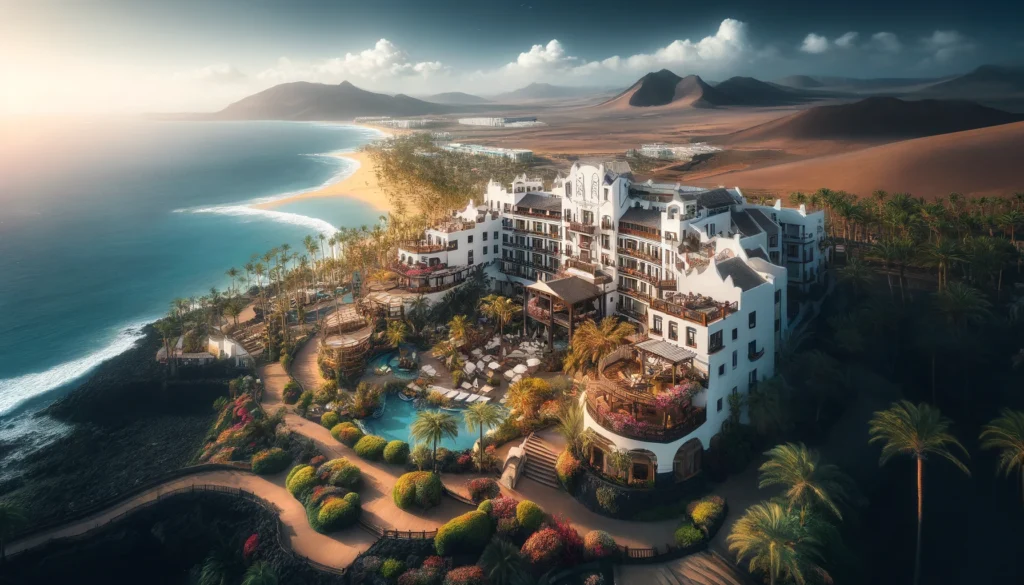
The Canaries are a popular resort where tourists arrive at any time of the year. A good vacation is facilitated by magnificent beaches, developed infrastructure, a large selection of hotels.
On the coast of Tenerife, Gran Canaria, Fuerteventura, you can find luxurious 5* hotels and affordable 3-4* ones.
The Canaries have hotels of world-renowned chains: H10, Best, Melia Hotels International, Iberostar, and more.
Booking a room in a chain hotel, you can be sure of a high level of service.
The cost of staying in hotels starts from 15 euros for a bed in a hostel, a room in a 4-5* hotel will cost 45-80 euros per day.
The Islands
Tenerife

Tenerife is the largest and most populous island of the Canary archipelago. A popular European resort, thanks to its unique climate, tourists visit Tenerife all year round. Despite its relatively small size, its southern and northern parts have significantly different climates. The south of Tenerife is protected from cold trade winds by a mountain plateau, making it almost rain-free and always sunny. The south is home to popular resorts like Las Americas, Los Cristianos, and Costa Adeje.
The north of Tenerife has a more humid climate, which positively affects the amount of vegetation around. The northern part is always green, with fertile valleys growing grapes, vegetables, and fruits. Its capital, Santa Cruz de Tenerife, is located in the northeast.
Despite the cooler weather, tourism is also developing in this area, swept by northern trade winds. Tenerife’s very first resort – Puerto de La Cruz is located in the north and traditionally popular among tourists from Western Europe.
Vacationing in Tenerife is not only about sun and beaches; it is interesting for its natural and historical attractions, as well as amusement parks.
To make your vacation unforgettable, be sure to ascend Mount Teide, which is the highest point in Spain, walk through the Masca Gorge, admire the Los Gigantes cliffs. With children, it’s worth visiting Siam Park, Loro Parque, and the Eagle Park.
Gran Canaria
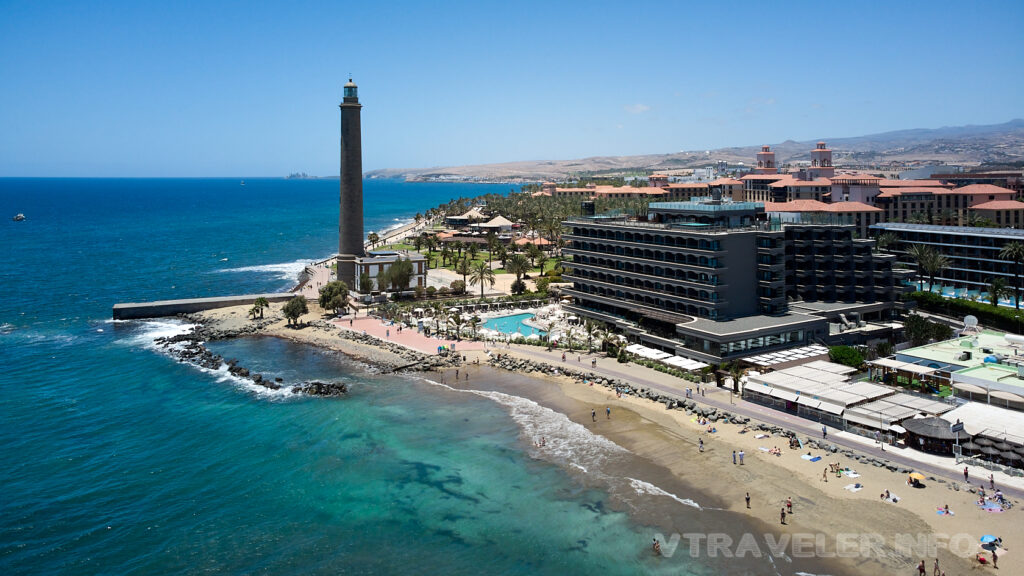
Gran Canaria is the third-largest by area and second in population in the Canary archipelago. It is located just 60 miles from the African coast. The volcano Pico de las Nieves in the central part divides it into northern and southern parts. The volcano’s height is 1949 m. The capital of Gran Canaria and the second capital of the Canary autonomous community is Las Palmas de Gran Canaria.
Gran Canaria is called a continent in miniature; in one day, you can visit the mountains, where it’s quite cool, the Maspalomas dunes, resembling a desert, and the coast.
Most hotels and equipped beaches are located in its southern part. It is reliably protected from winds and cold trade winds. The northern beaches of Gran Canaria attract surfers and windsurfers, as they are always windy.
The most spectacular beach of Gran Canaria is Maspalomas Beach, closely followed by the beach in the capital, stretching 4 km.
The main tourist centers of Gran Canaria are Maspalomas, Puerto Rico, and Puerto de Mogan.
The most famous attraction of Gran Canaria is the Maspalomas sand dunes, resembling a miniature desert. Also, Gran Canaria has an interesting Botanical Garden, Archaeological Museum, and Columbus House, Crocodile Park, and the Bandama volcano caldera. For children, it is worth visiting the Holiday World amusement park, the Ocean Park water park, and the aqua park.
Fuerteventura
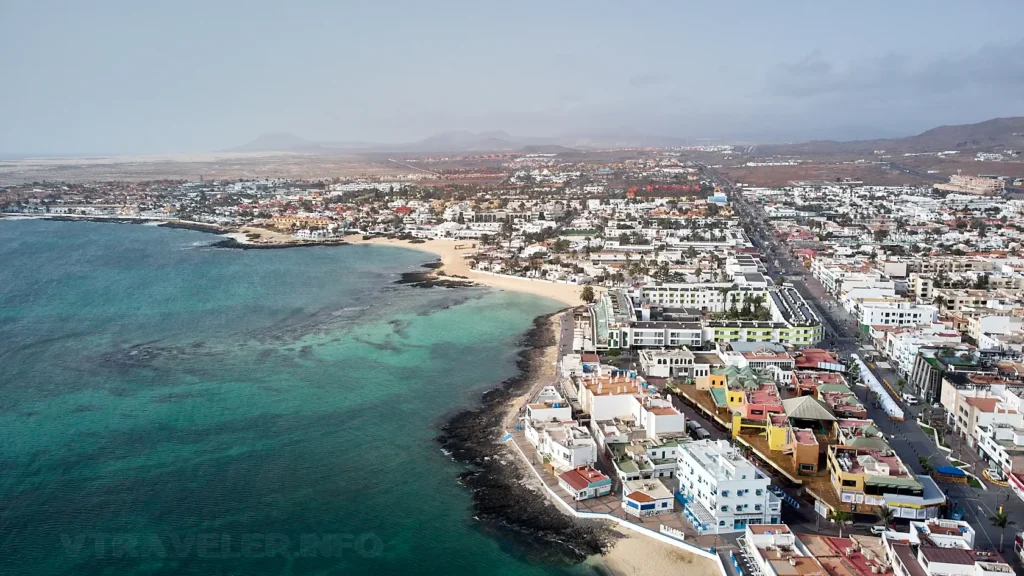
Fuerteventura is considered the second-largest island of the Canary archipelago. Despite its size, it is sparsely populated, and the tourist infrastructure is underdeveloped. Once, Fuerteventura was almost entirely forested, but during the times of Spanish conquistadors, forests were cut down for shipbuilding. Today, its vegetation is quite sparse, and it is practically unprotected from winds.
Its capital is Puerto del Rosario.
The main resorts of Fuerteventura are located on the Jandia peninsula: Costa Calma, Playa Matorral, Morro del Jable, Playa de Corralejo, Caleta de Fuste. They are perfect for a quiet family vacation.
Fuerte has several dozen beaches with white sand. Beaches in the north and west are popular with surfers due to constant winds.
The largest beach of Fuerteventura is Sotavento, located in its eastern part. Its length is 30 km.
There are not many attractions on the island. The main one is the “Dunes of Corralejo” National Park.
The highest point is Pico de la Zarza with a height of 807 meters, several scenic hiking trails are laid across the mountain.
Lovers of exotic plants should visit the cactus park, which houses a collection of 2500 species of succulents.
It would be very interesting to visit the town of Betancuria, where ancient buildings are well-preserved. An archaeological museum is also located in the town.
Lanzarote
Lanzarote is the fourth-largest and the easternmost island among the Canary Islands. Lanzarote is quite different from its neighbors, as about 300 volcanoes are found on its surface. Hence, it is also called the “island of fire-breathing mountains”. A significant part of Lanzarote is covered with volcanic ash and basalt. Lanzarote’s calling card is its unique lunar landscapes. A significant portion of the island is part of a reserve, so the places where you can freely walk are limited.
The best beaches of Lanzarote are located in the southern part of the island, in Papagayo Bay. The white sand, turquoise sea, and clear water attract tourists.
There are only three resorts on Lanzarote: Costa Teguise, Playa Blanca, and Puerto del Carmen, and due to constant winds, they are more popular with surfers than with beachgoers.
Among the attractions of Lanzarote, Castillo de San Jose, built in the 18th century, presents a certain interest. Inside the castle is a museum of contemporary art.
It is also worth checking out the volcanic array La Corona, the cave Cueva de los Verdes, the green crater El Golfo.
Separately, objects created jointly by nature and man need to be highlighted: the Cactus Garden, Famara cliffs, Jameos del Agua caves. These are creations of Cesar Manrique, a friend of Picasso.
La Palma
A small island belonging to the Canary archipelago. It is of volcanic origin, some volcanoes are active even now, the last eruption was in 1971. La Palma is very green and the warmest of the Canary Islands. In 2002, La Palma was declared a UNESCO World Biosphere Reserve. It is one of the few places on the planet where relict pine and laurel forests have been preserved.
But tourism on La Palma is only developing – due to the rocky coastline, it feels a lack of comfortable beaches.
The most famous resorts of La Palma: La Fajana, Santa Cruz, Los Cancajos, Charco Azul.
The largest beach with black volcanic sand is located at the Puerto Naos resort. It has been awarded the Blue Flag multiple times, confirming its cleanliness and safety.
For a vacation with children, Charco Verde beach is suitable.
There are few attractions on the island. Historical and architectural objects are concentrated in the capital, so if you want to know more about the island’s history and admire the ancient architecture, head to Santa Cruz de la Palma.
La Gomera
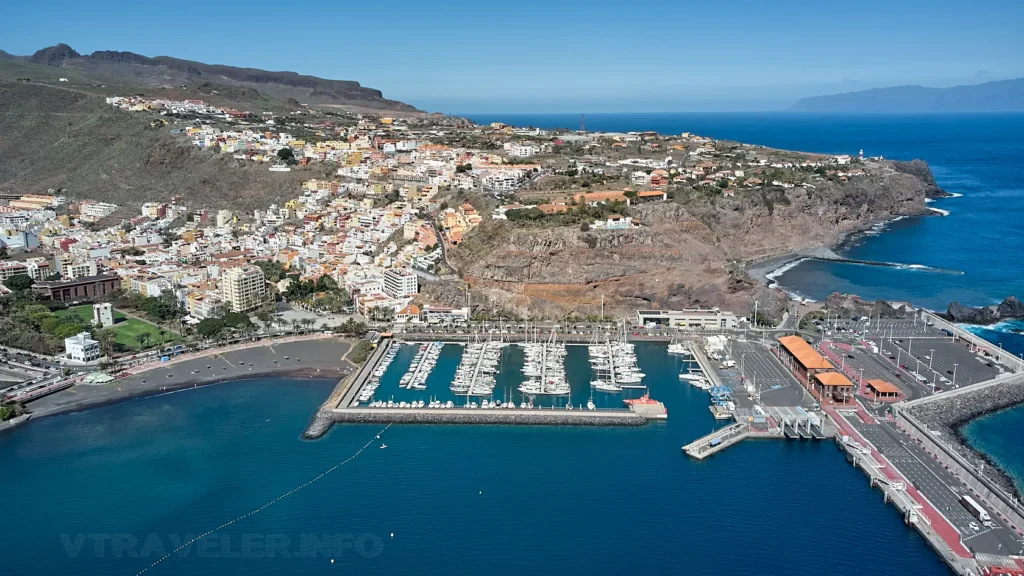
La Gomera is one of the most beautiful in the Canary archipelago, but as a resort, it is underdeveloped. Most tourists come to La Gomera for a one-day excursion.
The only resort here is Valle Gran Rey, which covers the area of several villages. European tourists mainly vacation at the resort.
The capital is San Sebastian de La Gomera. Most attractions are concentrated exactly there. During the excursion, it’s worth seeing the Fortress of Christopher Columbus, the Church of Virgen de Asuncion, where, according to legend, Christopher Columbus prayed before his voyage, the Tower Torre del Conde. It is also interesting to walk through laurel forests, where trees reach 20 meters in height, mountain paths, and ravines.
In the local Garajonay National Park, about 450 species of rare plants are collected.
El Hierro

El Hierro is the smallest of the Canary Islands. It is of volcanic origin and the last underwater volcanic eruption occurred quite recently – in 2011. Tourism is practically undeveloped, as there are almost no sandy beaches on El Hierro.
The capital is the town of Valverde.
Few tourists come here to go diving at the La Restinga resort, which has the status of a marine nature reserve.
The only historical monument is the church of Santa Maria de la Concepcion, built in 1767.
El Hierro also has the La Garajonay nature reserve, where rare species of lizards live.
La Graciosa
La Graciosa is the only inhabited island among the small islands of the Canary archipelago. Its total area is only 27 sq. km, and it is located just 2 km from Lanzarote. La Graciosa is not touristy, the local population consists of fishermen and port workers.
There are only two settlements on it – the villages of Caleta del Sebo and Pedro Barba.
Car traffic is prohibited on La Graciosa, the only available transport is a bicycle.
There are no hotels on it, so tourists come for one day.
The main attraction of the island is the magnificent beach Playa de las Conchas with golden sand.

